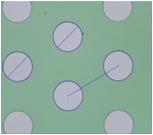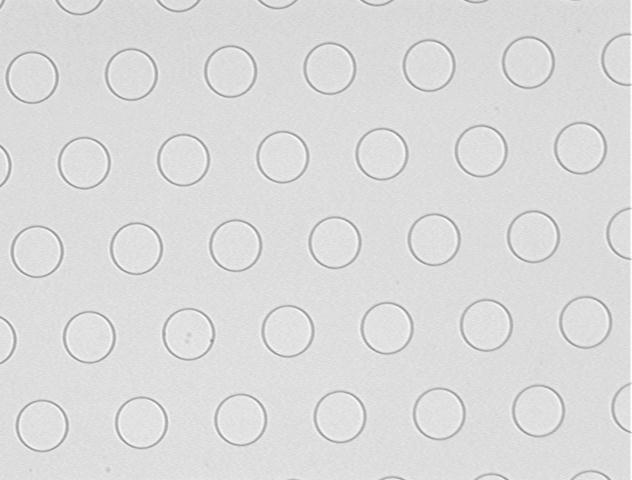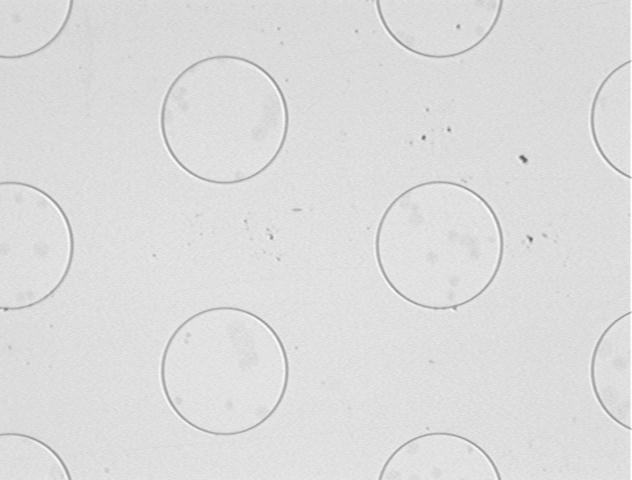|
MICRODISC ELECTRODE
ARRAYSTM
(MDEAs) |
|
MDEA DEVICES |
Number of Discs |
Disc dimensions |
Active Area |
Conductor |
|
MDEA 360 |
1 disc |
3,600 microns diameter discs |
0.10 cm2 |
Au, Pt, ITO |
|
MDEA 250 |
207 microdiscs |
250 microns diameter discs |
0.10 cm2 |
Au, Pt, ITO |
|
MDEA 100 |
1,296 microdiscs |
100 microns diameter discs |
0.10 cm2 |
Au, Pt, ITO |
|
MDEA 050 |
5,184 microdiscs |
50 microns diameter discs |
0.10 cm2 |
Au, Pt, ITO |
|
|
|
|
|
|
MDEA Brochure (PDF) |
|||||
|
|||||||||
|
Ø Chip Substrate: |
Schott D263 Borosilicate Glass |
|
|||||||
|
|
Dielectric Constant, Epsilon(r) at 1 MHz |
6.7 |
|||||||
|
|
Dielectric Loss Angle, tan delta, at 1 MHz |
61 x 10-4 |
|||||||
|
|
Electrical Resistivity (50 Hz) (250 C) |
1.6 x 10^8 ohm cm |
|||||||
|
|
Coefficient of Linear Thermal Expansion, * 20-300 Deg C |
7.2 x 10^-6 K^-1 |
|||||||
|
|
Refractive Index at 20 C, ne ( Lambda = 546.1 nm) |
1.5249 |
|||||||
|
|
|
|
|||||||
|
Ø Metallization: |
100 Å Ti|W / 1000 Å Au or Pt and ITO = 10 Ohms/sq |
|
|||||||
|
|
|
|
|||||||
|
Ø Insulating Top Layer: |
Silicon Nitride (Si3N4) |
|
|||||||
|
|
|
|
|||||||
|
|
|
No of Discs |
Electroactive Area (cm2) |
Geometric Area (cm2) |
|||||
|
Ø MDEA 360 |
A single disc, 3.60 mm in diameter. |
1 |
1.0 x10-1 |
1.0 x10-1 |
|||||
|
Ø MDEA 250 |
207 separate discs, each 250 mm in diameter and arranged 500 mm on centers in a hexagonal close packaed array. |
207 |
1.0 x10-1 |
4.5 x10-1 |
|||||
|
Ø MDEA 100 |
1,296 separate discs, each 100 mm in diameter and arranged 200 mm on centers in a hexagonal close packaed array. |
1,296 |
1.0 x10-1 |
4.5 x10-1 |
|||||
|
Ø MDEA 050 |
5,184 separate discs, each 50 mm in diameter and arranged 100 mm on centers in a hexagonal close packaed array. |
5,184 |
1.0 x10-1 |
4.5 x10-1 |
|||||
|
|
|
|
|
|
|||||
|
Ø MDEA Chip Dimensions |
Un-packaged Die |
Packaged Die |
|||||||
|
|
(l x w x t) |
(l x w x t) |
|||||||
|
MDEA XXX |
2.00 x 1.00 x 0.05 cm |
13.2 x 1.38 x 0.7 cm |
|||||||
|
|
|
|
|||||||
|
Ø Packaging |
|
|
|||||||
|
Electrode Body: |
PVC-Jacketed printed circuit board |
||||||||
|
Encapsulant: |
Epoxy header. Polyimide packaged chip. |
||||||||
|
Leadwires: |
Color coded, 28 AWG stranded copper, shielded, and PVC jacketed |
||||||||
Back to Index |
|||||||||






